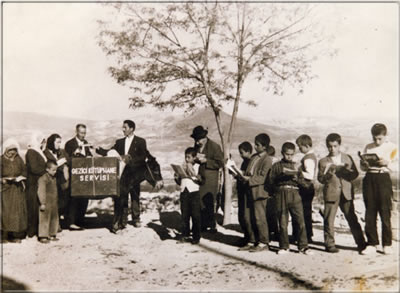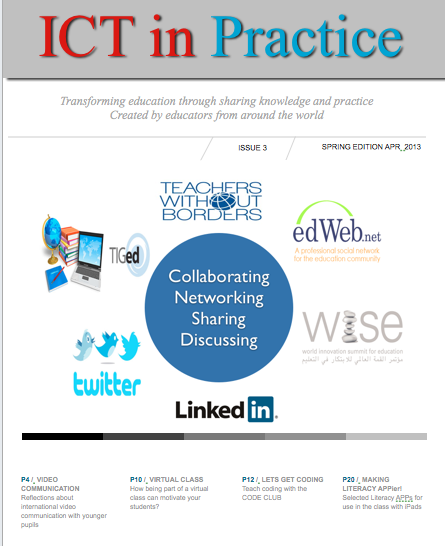by Yasemin Allsop
Recently I read many articles on the internet blaming technology for children’s lack of language skills. I can’t say I am surprised. I agree that technology is changing the way we use language. I am sure that you have spent time trying to understand your child’s text messages. I certainly did. When I receive text messages from my son, I sometimes have to google them or phone and ask him exactly what he meant with all these acronyms and abbreviations.
Looking at my own teaching practice, I have used wikis, blogs, animations, films, podcasting, web design, game making and many other technology tools to teach over the years. Each one of these mediums offers great opportunities for children to develop their language skills. I remember when our Year 5 students wrote their own children’s rights raps and recorded them using their backing music. They didn’t just create their songs, they spent a long time discussing their ideas before deciding. I also remember our web design activities. Where children had to create their own content and use html to design websites to present their work. The amount of reading and writing they had to do and not even one complained.
So what is the problem here? Are we still thinking of technology as a magical wand designed specifically to solve our long standing issues in education. We need to abandon this idea by now as technology never had such a claim. Technology appeared in our classroom as a teaching tool used by teachers, remember our IWBs, then it swiftly changed position and became a learning tool in the hands of our learners. I believe this was more confusing for us than the learners. Our learners quickly adapted into their new role. But us teachers we are still thinking about where we fit into this scene. If the learners are holding the tool, what are we going to hold? How are we going to teach? Do we need to teach? Do they need us? Are they listening? Are they learning? How do I manage the classroom now? We all go through these endless worries. I think the reason for this confusion is that we don’t exactly understand how children learn with these new technologies and we haven’t got the time to find out about it. So, why not blame the technology?

Once one of my tutors told me that a pencil is also a technology. It didn’t make sense to me at the time, but when I think about it, he was right, a pencil is also a technology tool. You can use it for different purposes; for writing stories, for drawing, for taking notes or mixing your tea which I have done many times. But if your hand writing is not very good, would you blame the pencil for it? Something to think about!
Let’s go back to our conversation about language. For many years language was seen as just a tool for communication. This approach today is still very current and impacts on our pedagogical approach to learning. But I am thinking about my own observations of children learning using technology for the last 10 years. Especially over the last few years where we have focused a lot on computer game design, there is a clear shift in the use and purpose of language. I watched children touching the computer or tablet screen and mumbling when making their own computer games. I observed them planning their work-sometimes aloud when creating their own world in Minecraft, or questioning their own decisions when creating websites. What was interesting is that as the task became more complex, the percentage of children’s self-talk activities also increased. It seems to me that they did not use language merely as a tool to communicate, it become a function in their minds. For my learners, language became a function to think with, a function to decide with, a function to regulate their own learning. This is not a new concept either, Vygotsky mentioned private speech in the 1970s. He argued that private speech is form of thinking, problem-solving and self-regulating. All this self-directed talk helps my learners to focus, plan, make decisions, organise. In other words it supports them to process tasks using their cognitive resources.
Another issue is that we don’t seem to grasp how new technologies impact on our learning behaviours. Look at the image below, does it look familiar to you? Probably not. This is a travelling library for people in Turkey during the 1940’s. It was aimed to help those living in rural areas to have an opportunity to read. I recently found out about this and I am so fascinated by the idea. I am not familiar with it as I was brought up in a city, not that I have been to the library. I didn’t even know what it meant. But my friends have seen these government librarians travelling from village to village on a donkey. What kind of learning habits would they have developed when they accessed knowledge through this way? What would they do with what they had learned from the book. Have a discussion? Create things? I don’t know, but today when our learners in their expression ‘can touch their learning’ on their smart phones or tablets, you can imagine they would have completely different learning habits.
When will we realise that learning is not an outcome, it is a process and the process doesn’t just stop with an end product. Learning is a quest powered by endless adventures spurting out from every corner of one’s mind on the way. It is at the next stage of what learners do with what they have learnt that is remarkable. They use their experience to share, make, or to create something, in other words go on a new learning journey. Look at the videos, podcasts, photos, stories, songs, games shared online by children, young adults and adults. Surely we are not learning in the same way as we did before. So let’s go back to our question ‘Is technology damaging our children’s language development?. My answer is, it depends on which specific technology is used and how. If we focus on how technology shapes our learning habits rather than pointing fingers at technology, we could develop better strategies to support our learners.















